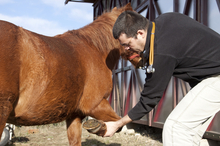One of the most devastating equine diseases is laminitis. With myriad causes, no fully reliable treatment and often a dismal prognosis in severe cases, laminitis is a dreaded diagnosis. A new collection of research published by the Equine Veterinary Journal updates equine veterinarians and interested members of the public on the latest knowledge in laminitis treatment and prevention.

A horse lameness exam
A new collection of research published by the Equine Veterinary Journal updates equine veterinarians and interested members of the public on the latest knowledge in laminitis treatment and prevention.
Laminitis is the inflammation of the sensitive structures (laminae) of the hoof that essentially hold the internal structures to the hoof wall. The term is often used interchangeably with founder, but founder is a more severe condition resulting from laminitis. When the inflammation becomes severe, the internal structures, namely the coffin bone, can detach and begin to rotate. That rotation is known as founder.
Causes of laminitis include too much fresh grass or rich feeds, concussion from working on hard surfaces and retained placenta in broodmares. Exposure to the wood of black walnut trees can lead to laminitis. Obesity is considered a risk factor for the condition. While management practices can reduce a horse’s risk of founder, with so many potential causes, the risk is always present.
According to the research, displacement of the pedal bone within the hoof capsule occurs because of disruption of the dermo-epidermal laminar bond within the hoof. The initiating changes leading to such degenerative responses are not known, but these changes in hoof biology are associated with persistent pain as evidenced by resistance to weight bearing on that hoof and increased manifestation of stress, including autonomic responses (heart rate variability and hypertension) and release of adreno pituitary hormones.
The severity of this pain state is of such enormity that animals may be euthanized for humane considerations. The mechanisms of this equine pain state are poorly understood, but it shows remarkableparallels to other mammalian systems which have been studied in detail, such as for the innervation of skin, joints, and tooth pulp.
The laminitis publication from the Equine Veterinary Journal offers free resources covering some of the latest research into the condition. The published research includes topics ranging from evidence to support the use of cryotherapy (ice) in early stages to slow the progression of the inflammation to the role of insulin in laminitis in ponies.
“Increasingly, horse owners will research ailments suffered by their animals with the Internet and laminitis is often targeted in this respect by horse owners desperate to find solutions for their afflicted animals,” writes Equine Veterinary Journal Editor-in-Chief Celia M. Marr.
“There is a problem, however, that much of the freely available material lacks rigour and quality. Many scientific journals, including EVJ, are generally not available to nonsubscriber.
EVJ is providing free access to information of particular welfare importance and interest to the equine community and a virtual issue has been launched drawing together 15 original Research Articles available to the public
Read more about Laminitis
